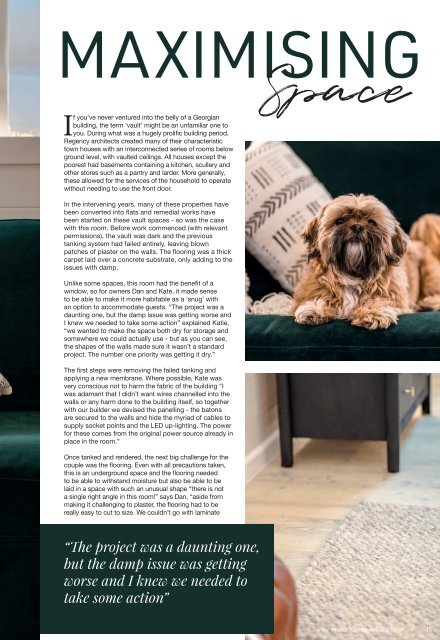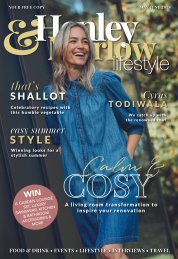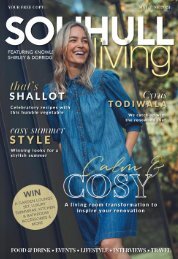Stratford-upon-Avon Living Jan - Feb 2021
Our first issue of 2021 - we are celebrating the good things COVID has brought - an appreciation of local businesses, a better sense of community, and more time to work on our homes. We have a real-life room transformation, plus the usual dose of recipes and interviews.
Our first issue of 2021 - we are celebrating the good things COVID has brought - an appreciation of local businesses, a better sense of community, and more time to work on our homes. We have a real-life room transformation, plus the usual dose of recipes and interviews.
You also want an ePaper? Increase the reach of your titles
YUMPU automatically turns print PDFs into web optimized ePapers that Google loves.
MAXIMISING<br />
f you’ve never ventured into the belly of a Georgian<br />
building, the term ‘vault’ might be an unfamiliar one to<br />
Iyou. During what was a hugely prolific building period,<br />
Regency architects created many of their characteristic<br />
town houses with an interconnected series of rooms below<br />
ground level, with vaulted ceilings. All houses except the<br />
poorest had basements containing a kitchen, scullery and<br />
other stores such as a pantry and larder. More generally,<br />
these allowed for the services of the household to operate<br />
without needing to use the front door.<br />
In the intervening years, many of these properties have<br />
been converted into flats and remedial works have<br />
been started on these vault spaces - so was the case<br />
with this room. Before work commenced (with relevant<br />
permissions), the vault was dark and the previous<br />
tanking system had failed entirely, leaving blown<br />
patches of plaster on the walls. The flooring was a thick<br />
carpet laid over a concrete substrate, only adding to the<br />
issues with damp.<br />
Unlike some spaces, this room had the benefit of a<br />
window, so for owners Dan and Kate, it made sense<br />
to be able to make it more habitable as a ‘snug’ with<br />
an option to accommodate guests. “The project was a<br />
daunting one, but the damp issue was getting worse and<br />
I knew we needed to take some action” explained Katie,<br />
“we wanted to make the space both dry for storage and<br />
somewhere we could actually use - but as you can see,<br />
the shapes of the walls made sure it wasn’t a standard<br />
project. The number one priority was getting it dry.”<br />
The first steps were removing the failed tanking and<br />
applying a new membrane. Where possible, Kate was<br />
very conscious not to harm the fabric of the building “I<br />
was adamant that I didn’t want wires channelled into the<br />
walls or any harm done to the building itself, so together<br />
with our builder we devised the panelling - the batons<br />
are secured to the walls and hide the myriad of cables to<br />
supply socket points and the LED up-lighting. The power<br />
for these comes from the original power source already in<br />
place in the room.”<br />
Once tanked and rendered, the next big challenge for the<br />
couple was the flooring. Even with all precautions taken,<br />
this is an underground space and the flooring needed<br />
to be able to withstand moisture but also be able to be<br />
laid in a space with such an unusual shape “there is not<br />
a single right angle in this room!” says Dan, “aside from<br />
making it challenging to plaster, the flooring had to be<br />
really easy to cut to size. We couldn’t go with laminate<br />
Space<br />
“The project was a daunting one,<br />
but the damp issue was getting<br />
worse and I knew we needed to<br />
take some action”<br />
www.stratford<strong>upon</strong>avonliving.co.uk | 15


















